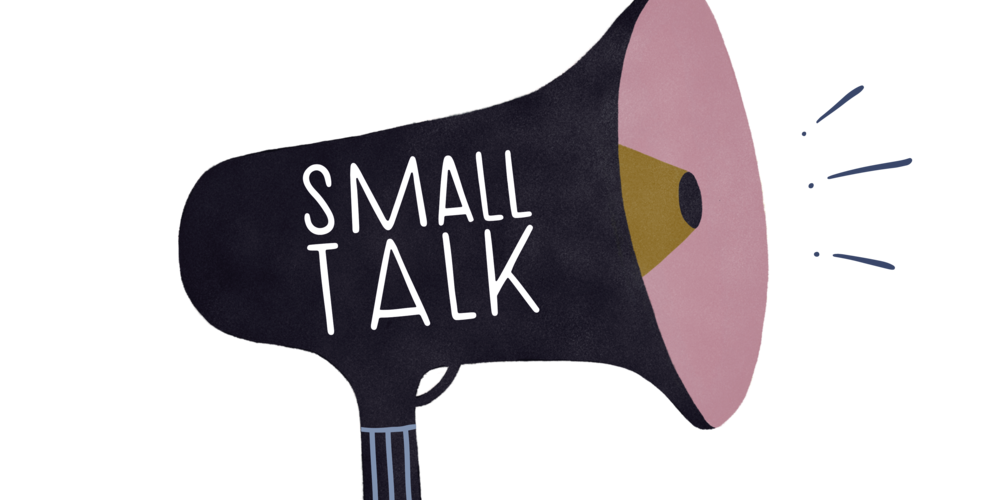Small talk occupies many aspects of our lives. Although many think it’s a meaningless conversation, it is actually crucial in establishing new relationships whether it was in friendship, romance or business.
A lot of people get anxious at the thought of starting small talk that they actually forget about all the advantages and opportunities waiting ahead, so they just avoid them. There are a lot of tips and strategies to help you overcome this fear and master the art of small talk that will be presented through these points :
- Small talk can be learned
- You’re responsible for initiating the conversation
- Continuing the conversation
- Digging deeper conversations
- Keeping the conversation alive
- Using body language and verbal cues
- Exiting a conversation gracefully
Small talk is a skill that can be learned:
No one is born with naturally good communicating skills, small talk is a skill that can be learned even by shy people. Sure, some people are naturally able to navigate social situations better than others. But most of us have to work to develop our conversation skills.
It’s up to you to initiate a conversation with someone; in fact, it’s a mistake not to.
Many people avoid small talk in fear of rejection, so it’s up to you to take that risk and start talking to people you want to know about. To do that you first have to let go of the idea of rejection: People appreciate when you show a little effort to speak to them, so try starting a conversation with people who showed interest, made eye contact, or are alone. This tip is especially important for shy people.
Once you’ve approached someone, initiating the conversation is pretty simple, you must smile, make eye contact, and introduce yourself while offering your hand for a handshake.
Sometimes there will be situations when you want to approach a group of people. To do that you must first demonstrate your interest to the group from a distance, paying attention to the speaker. In most cases, the group will notice and make room to include you. Once you’re in, try to let the group warm to you before you offer any strong opinions.

Assume the burden of a conversation by learning people’s names and preparing icebreakers
Expert communicators know that guiding a conversation evokes the positive feelings that make people want to work or socialize with them. One easy way of assuming the responsibility for guiding a conversation is to act like you’re a host. Focus on learning the name of each person you speak to. After you introduce yourself, ask your conversation partner “What’s your name?” Put the emphasis on “your” to make them feel valued.
Each time a new arrival joins the group, introduce them.
After introductions, it’s your responsibility to choose the conversation topic. Try asking thoughtful questions that lead to in depth and long-lasting conversations. For example, try asking how they got started in the industry if you’re at a business event, or about their hobbies if it’s a social function. Your questions don’t need to be bold, but one of your goals should be to make your conversation partners feel comfortable by demonstrating your interest in them.
Asking open-ended questions and digging deeper improves conversations:
If you want to be a better conversationalist, you need to dig deeper and break out of the mundanity of everyday inquiries. Try asking open ended questions. They help demonstrate to your conversation partners that you genuinely care about what they have to say. They enable you to dig deeper into a speaker’s response without being invasive or demanding. Questions like “What did you think about that movie?” allow respondents to determine how much information they’re willing to share with you.
In case someone asks you, for example, about how you spent your weekend, you should respond with an anecdote about your weekend and ask them about theirs. This way, you set an example for the kinds of conversations you want to have, even though you’re not the one starting the conversation.
It’s up to you to know what is appropriate to ask in a given context. But it’s also important to pay attention to how your conversation partner reacts. If you ask your colleague something personal and he changes the topic back to business, it’s likely a sign that he doesn’t want to engage in small talk at that time. Respect his choice and shift back to his preferred topic of conversation.

Use varied questions and environmental clues to keep conversations alive:
When a conversation starts to feel awkward, take the reins and get the conversation back to a comfortable flow. To do that you must ask a new open-ended question that changes the direction of the discussion. If you have trouble thinking of open-ended questions on the spot, you can trigger your memory with the acronym FORM: family, occupation, recreation and miscellaneous. While the first three categories are self-explanatory, the miscellaneous category is an opportunity to be more imaginative.
Another way to get the conversation going again is to look out for clues by paying attention to your surroundings and the person you’re speaking to. What the person is wearing, the venue you’re in or details about the event you’re attending are all easy topics that you can draw upon when the conversation slows down, or when you’re looking to start a new conversation.
But beware! Bringing up gossip, controversial issues or personal misfortunes will in most cases leave your conversation partner with a negative impression of you.
Paying careful attention to body language and verbal cues will make you a better listener:
For a conversation to go well, both parties need to feel understood, appreciated and, above all, listened to. That means that in addition to taking on the burden of a conversation, you also need to be an active listener.
One way of indicating that you’re listening is through body language: Avoid crossing your arms, hunching your shoulders or fiddling with your clothes, hair or jewelry. Instead, lean forward, nod, smile and maintain eye contact.
Another way to do so is verbal cues you give a speaker to show that you’re actively listening, you can: ask a follow-up question about specific details of a story, respond enthusiastically. In some situations, paraphrasing what the speaker has said can be useful to clarify information and prevent misunderstandings.

Exiting a conversation gracefully and honestly can enhance the connection you’ve made.
No matter how well a conversation is going, a poorly executed conclusion can stain the entire interaction, you should always make an effort to exit every encounter with gracefully. Luckily, there are a few easy ways to conclude any conversation skillfully. The first thing to do is to circle back to the highlight of your discussion. You can also comment on how fantastic it was to discuss this particular topic. If you genuinely want to continue the discussion at a later date or simply exchange emails, it’s up to you to assume the burden of politely requesting a follow-up. Then, once you’re finally ready to end the interaction, state what you’re going to do next, shake your acquaintance’s hand and say goodbye. It’s important that follow through with whatever it is you say you’re doing next.
Another way to end a conversation is to introduce your conversation partner to a new person who joins your group before excusing yourself. This will help your initial acquaintance widen his own network, and should ensure that he doesn’t feel that you’re abandoning him.
Finally, you should always engage in small talk, think about the all the opportunities and relationships you would miss if you didn’t start a conversation with someone. Greet your conversation partner, choose a topic you want to talk about, and finally make sure to respect their privacy and exit the conversation gracefully


